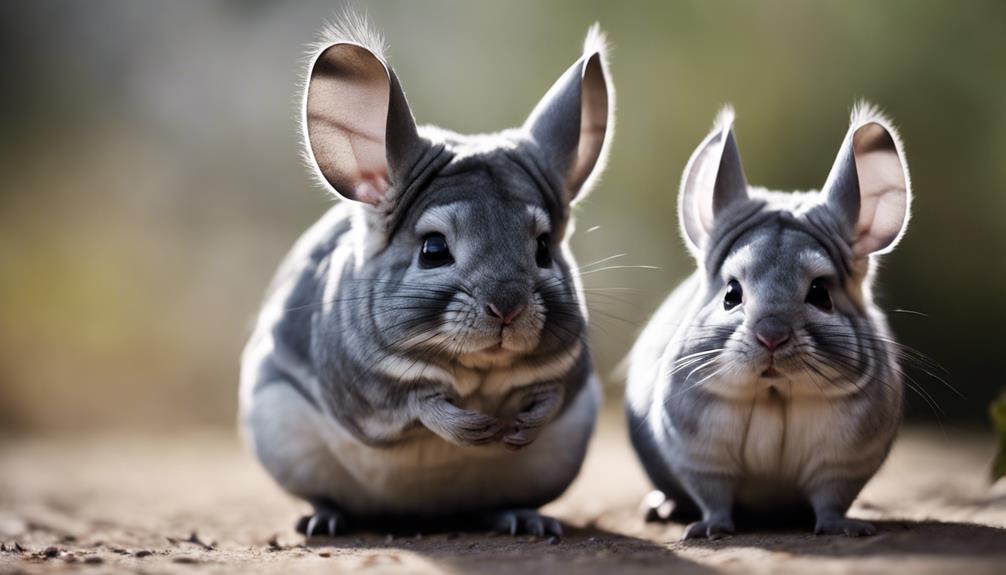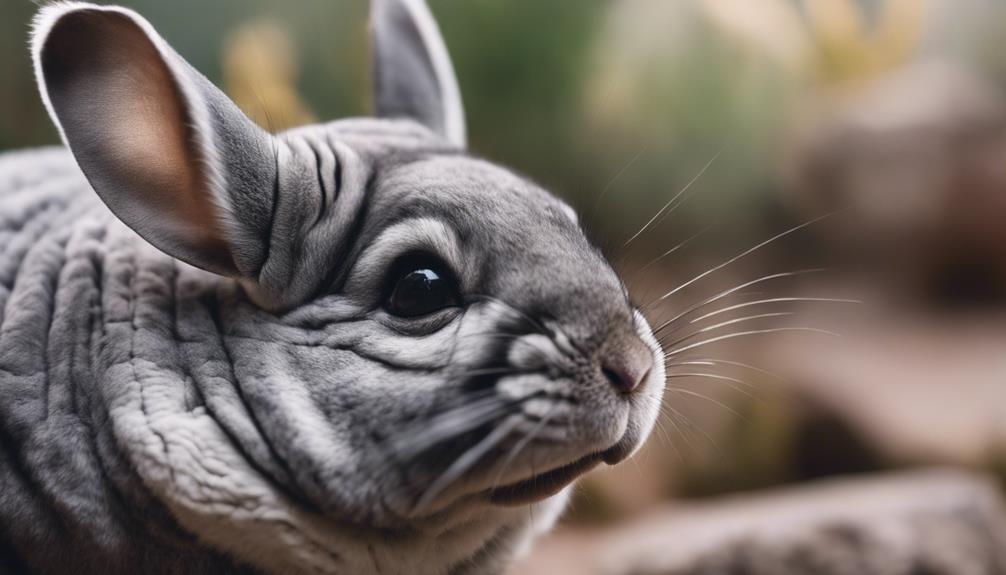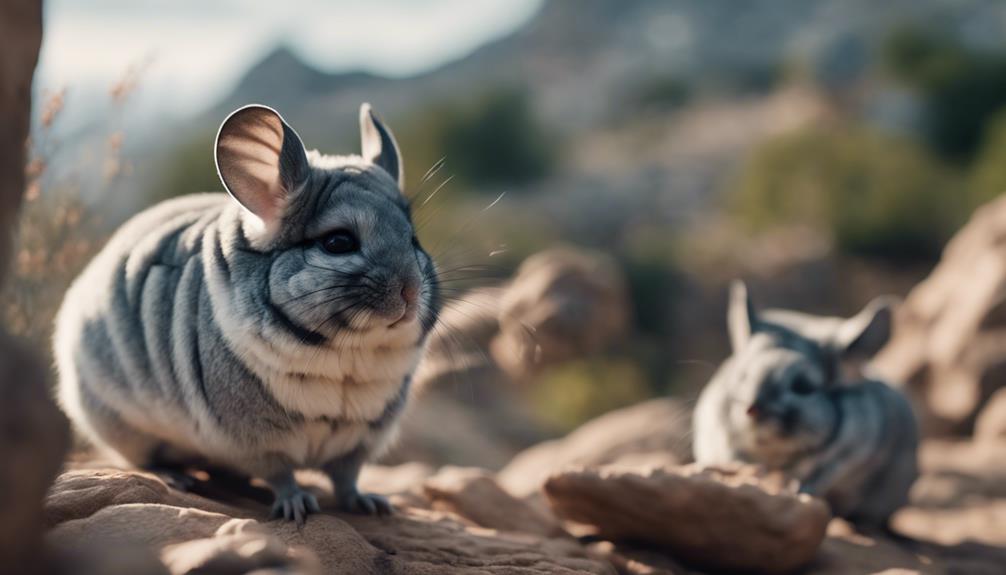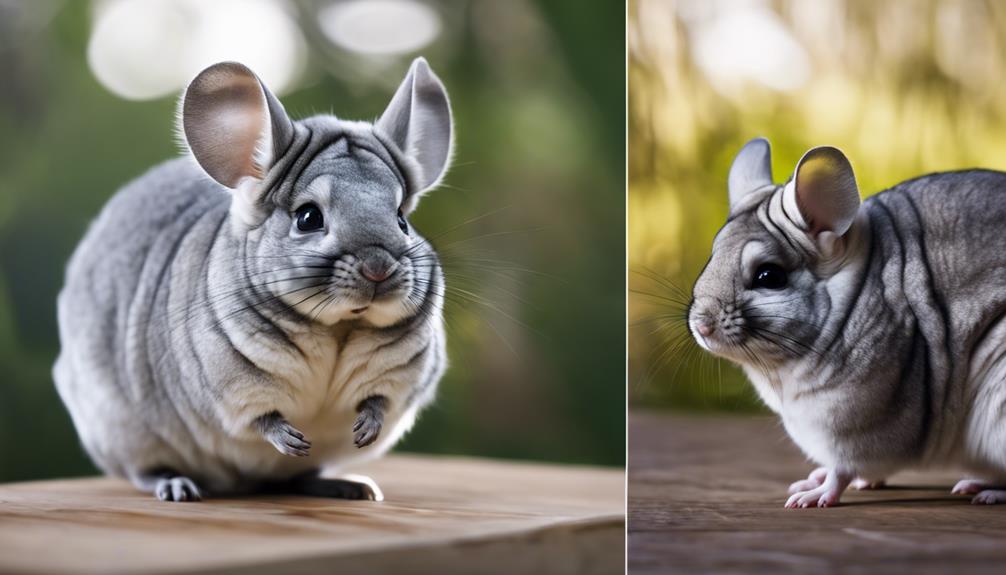How to Differentiate Between Wild and Domestic Chinchilla Species

Differences Between Wild and Domestic Chinchilla Species:
- Fur coat:
- Behavior:
- Habitat:
- Diet variations set them apart.
Physical Differences Between Wild and Domestic Chinchillas
When comparing wild and domestic chinchillas, one can observe distinct physical differences that differentiate the two species. Wild chinchillas typically have a darker fur coloration, often ranging from grey to black, which aids in camouflage in their natural habitats. In contrast, domestic chinchillas exhibit a wider variety of fur colors, including white, beige, and mosaic patterns, which are a result of selective breeding.
Size differences also play a significant role in distinguishing wild from domestic chinchillas. Wild chinchillas tend to be smaller in size, with a leaner body structure that's adapted for agility and speed in their mountainous environments. On the other hand, domestic chinchillas are larger and more robust due to generations of breeding for desirable traits such as plush fur coats and docile temperaments.
Moreover, coat texture and ear shape variations further set wild and domestic chinchillas apart. Wild chinchillas have coarser fur with a dense undercoat to protect them from the harsh weather conditions, while domestic chinchillas often have softer, silkier fur due to breeding for luxurious pelts. Additionally, wild chinchillas typically have larger, more rounded ears compared to the smaller, more tapered ears of domestic chinchillas.
Behavioral Contrasts in Wild Vs. Domestic Chinchillas

Behavioral distinctions between wild and domestic chinchillas reveal contrasting patterns in their social interactions and responses to environmental stimuli. Wild chinchillas, due to their natural habitat, exhibit more pronounced predatory instincts and survival skills compared to their domestic counterparts. In the wild, chinchillas rely on these instincts to evade predators, locate food sources, and communicate with other members of their species. Their social interactions are primarily focused on establishing hierarchies, defending territories, and mating rituals.
On the other hand, domestic chinchillas, having been selectively bred for docility and tameness, display reduced predatory behaviors and heightened sociability towards humans. They often seek out human companionship and are more adaptable to living in close proximity to humans. In terms of communication, domestic chinchillas tend to vocalize more frequently to interact with their owners or express emotions, whereas wild chinchillas rely more on non-verbal cues and scent marking to convey messages within their social groups. Understanding these behavioral differences is crucial for providing appropriate care and enrichment for both wild and domestic chinchillas.
Habitat Variances: Wild Vs. Domestic Chinchillas

The habitat variances between wild and domestic chinchillas significantly influence their adaptation strategies and physiological responses to environmental stimuli. Wild chinchillas inhabit the Andes Mountains in South America, specifically in rocky, high-altitude regions with sparse vegetation. In contrast, domestic chinchillas are kept in controlled environments such as cages or pens within homes or breeding facilities. The natural habitat of wild chinchillas presents challenges that have led to specific environmental adaptations, such as their thick fur for insulation against cold temperatures and their ability to jump and climb rocky terrains with agility. On the other hand, domestic chinchillas have adapted to human-provided food and shelter, resulting in behavioral and physiological differences from their wild counterparts.
| Wild Chinchillas | Domestic Chinchillas |
|---|---|
| High-altitude mountains | Controlled environments |
| Sparse vegetation | Cages or pens |
| Thick fur for insulation | Human-provided food |
Reproductive Varied Traits in Wild/Domestic Chinchillas

In wild and domestic chinchillas, reproductive traits exhibit significant variations influenced by their distinct environmental adaptations and breeding conditions. One key difference lies in their reproductive cycles. Wild chinchillas, adapted to fluctuating seasons, have specific breeding periods triggered by environmental cues. In contrast, domestic chinchillas, removed from natural conditions, may exhibit more consistent breeding behavior throughout the year.
Genetic diversity also plays a crucial role in shaping reproductive traits. Wild chinchilla populations tend to have higher genetic diversity due to natural selection pressures, leading to a wider range of reproductive adaptations. In contrast, domestic chinchillas may have reduced genetic diversity due to selective breeding practices, which can impact their reproductive capabilities.
Understanding these differences in reproductive traits between wild and domestic chinchillas is essential for breeders and conservationists. It highlights the importance of considering environmental factors and genetic diversity when managing chinchilla populations to ensure their reproductive success and long-term viability.
Diet Disparities: Wild and Domestic Chinchilla Preferences

Wild and domestic chinchillas exhibit distinct dietary preferences influenced by their evolutionary history and captive environments. In the wild, chinchillas are herbivores with a diet primarily consisting of grasses, leaves, and seeds. Their digestive system is adapted for processing high-fiber foods, allowing them to efficiently extract nutrients. Wild chinchillas display foraging behavior, spending a significant amount of time searching for vegetation to meet their nutritional needs. Water consumption in the wild is minimal, as they obtain most of their moisture from their food.
On the other hand, domestic chinchillas have adapted to a diet provided by their owners, typically consisting of high-quality hay, pellets, and occasional treats like fruits and vegetables. Due to their captive environment, domestic chinchillas may have different food preferences than their wild counterparts. Owners must ensure a balanced diet to support their pet's health and well-being, including monitoring water consumption to prevent dehydration. Understanding these dietary disparities is crucial for properly caring for both wild and domestic chinchillas.
Domestication Process and Its Impact

The domestication process of chinchillas has led to significant changes in their behavior compared to their wild counterparts. Analyzing the impact of domestication on chinchilla behavior allows for a better understanding of how the selection process has influenced their traits.
Domestication Impact Analysis
Through the process of domestication, chinchillas have undergone significant genetic and behavioral changes that distinguish them from their wild counterparts. Domestic chinchillas exhibit specific traits resulting from selective breeding and captivity.
- Increased docility: Domestic chinchillas are typically more accepting of human interaction.
- Altered fur coloration: Selective breeding has led to a variety of fur colors not seen in the wild.
- Reduced fear response: Domestic chinchillas are less skittish compared to their wild counterparts.
- Enhanced reproductive capacity: Breeding in captivity has increased the fertility rates of domestic chinchillas.
These changes are indicative of the adaptation process that has taken place over generations in domestic chinchillas, setting them apart from their wild ancestors.
Behavior Changes Comparison
Behavior changes in domestic chinchillas compared to their wild counterparts reflect the profound impact of the domestication process on their genetic and behavioral traits. Domestic chinchillas exhibit altered social interactions, showing less territorial behavior than their wild relatives. Their activity levels tend to be lower, attributed to generations of selective breeding for docility. Communication signals between domestic chinchillas and wild chinchillas also show variations, with domesticated individuals relying more on human interaction for cues. The table below summarizes key differences in behavior between wild and domestic chinchilla species.
| Behavior Aspect | Wild Chinchillas | Domestic Chinchillas |
|---|---|---|
| Social Interactions | High levels of territorial behavior and dominance hierarchies | Reduced territorial behavior, more tolerant of group interactions |
| Activity Levels | Highly active, constantly on the move | Lower activity levels, more relaxed and sedentary |
| Communication Signals | Reliance on complex vocalizations and scent marking for interaction | More dependent on human cues for communication and social cues |
Conservation Efforts for Wild Chinchilla Species

Efforts to conserve wild chinchilla species involve implementing strict habitat protection measures and closely monitoring population trends. Conservation strategies play a crucial role in safeguarding these unique creatures from the threats they face in the wild.
Some key initiatives include:
- Captive Breeding Programs: Establishing programs to breed chinchillas in captivity helps ensure genetic diversity and acts as a safety net against population decline.
- Population Monitoring: Regularly monitoring wild chinchilla populations allows researchers to track changes, identify potential threats, and implement targeted conservation actions.
- Habitat Protection: Preserving the natural habitats of wild chinchillas is essential for their survival. This includes creating protected areas, enforcing anti-poaching measures, and restoring degraded habitats.
- Community Involvement: Engaging local communities in conservation efforts fosters a sense of stewardship and can lead to sustainable practices that benefit both chinchillas and humans.
Frequently Asked Questions
Are There Any Specific Genetic Markers That Distinguish Wild Chinchillas From Domestic Chinchillas?
Genetic differences between wild and domestic chinchillas play a crucial role in distinguishing them. While behavioral similarities exist, evolutionary adaptations and physical characteristics such as fur color variations and size differences are key indicators of their species.
How Do Wild Chinchillas Interact With Other Wildlife Species in Their Natural Habitat Compared to Domestic Chinchillas?
Wild chinchilla behavior in the wild involves minimal interaction with other wildlife species, focusing on survival and avoiding predators. Domestic chinchillas, on the other hand, have socialization patterns mainly centered around human interactions, forming bonds with their owners.
Do Wild Chinchillas Exhibit Different Grooming Behaviors Compared to Domestic Chinchillas?
Wild chinchillas exhibit unique grooming habits, vital for maintaining their fur's health. Domestic chinchillas, due to human interaction, may show different socialization patterns but share similarities in grooming behavior, highlighting their adaptability in varied environments.
Are There Any Cultural Beliefs or Superstitions Surrounding Wild Chinchillas That Differ From Those of Domestic Chinchillas?
Cultural beliefs and superstitions surrounding wild chinchillas often differ from those associated with domestic chinchillas. People may view wild chinchillas as mystical creatures with unique powers, while domestic chinchillas are seen as charming pets.
How Do Wild Chinchillas Cope With Environmental Changes Compared to Their Domestic Counterparts?
Wild chinchillas demonstrate remarkable behavioral adaptations to cope with environmental changes, enhancing their survival strategies. Their resilience to climate impacts is a key factor in their ability to thrive in diverse habitats.











